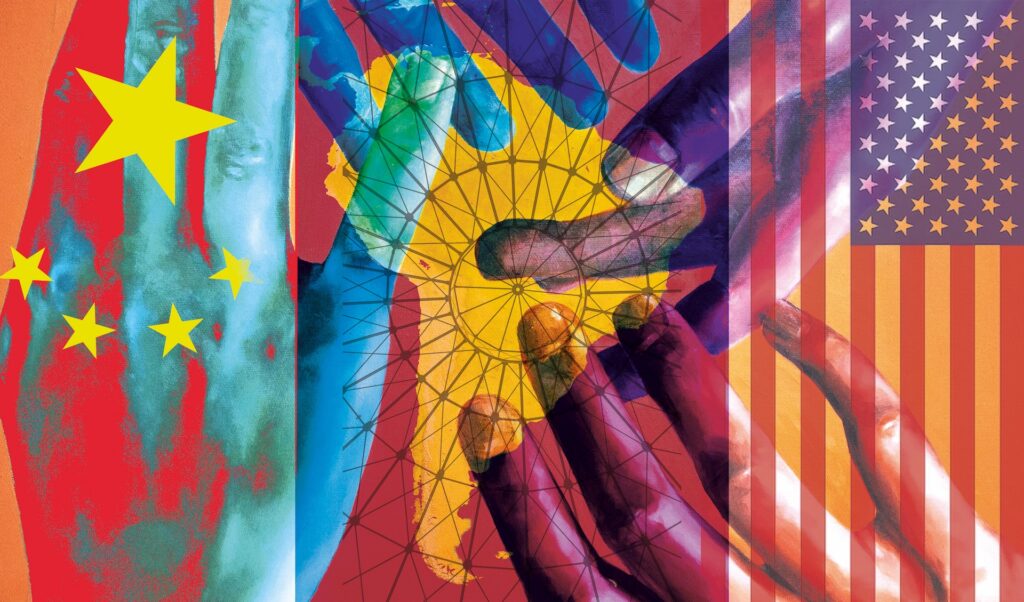Latin America and China face the new Trump administration

Credit: Illustration/Diálogo
By Marcos Cordeiro Pires* [Republicação] [China-América Latina] [Trump 2.0]
During his inauguration on January 20, the new president was asked about relations with Latin America and Brazil and said the relationship. Then, Donald Trump said “should be great,’ but he added: “They need us much more than we need them. We don’t need them. They need us. Everybody needs us.” This harsh response to a Brazilian journalist indicated to the world the main characteristics of his government policy.
On the same day, Trump announced the imposition of 25% tariffs on imports from Mexico and Canada, threatened to retake the Panama Canal, considered taking Greenland from Denmark, changed the name of the Gulf of Mexico to the “Gulf of America,” and began a relentless hunt for illegal immigrants, most of whom are of Latin American origin. Later, he announced the imposition of 25% tariffs on steel and aluminum, directly impacting Canada and Brazil, the two largest exporters to the United States.
Donald Trump seems to have a lot of contempt for his South’s neighbors. Still, this leniency is not genuine since the Washington government considers Latin America and the Caribbean its backyard, which is essential to supply strategic natural resources and security.
On February 13, Admiral Alvin Holsey, Commander of United States Southern Command, testified before the Senate Armed Services Committee on Feb. 13, 2025, as part of the command’s annual Posture Statement to Congress. Speaking about China’s presence in Latin America, he highlighted: “While the United States is looking to the Far East, China is plowing fertile ground to our south. The region is home to abundant natural resources, including 20 percent of the world’s oil reserves, 25 percent of its strategic metals, 30 percent of its forest area, 31 percent of its fishing areas and 32 percent of its renewable freshwater resources.5 Economics plays a central role in China’s interest in the region. Understanding this, China has used its Belt and Road Initiative (BRI) to become South America’s largest trading partner and second largest in Central America and the Caribbean.”
On March 05, The Senate’s Committee of Foreign Affairs organized a hearing to discuss the “Advancing American Interests in The Western Hemisphere.” Two important scholars testified to show the involvement of the People’s Republic of China with Latin American and Caribbean countries. They mentioned investments in the Belt and Road Initiative (BRI), the high level of trade interaction, military consulting with PLA, and fentanyl trafficking. Senators who attended the hearing highlighted a lot of prejudice against China and showed how containing its development is a bipartisan consensus.
It is interesting to note that Latin American and Caribbean countries are treated as “objects” by senior US leaders rather than as actors on the international stage who have sovereignty and their own interests face other countries and important blocs in the world. We can identify an attempt to infantilize our countries or that we are naive and do not understand the threats of a hypothetical “big bad wolf”.
Because of this perception, the relationship between Latin America, the Caribbean, and China is being tested at every turn. The threats against the government of Panama, for example, are having an effect, as there is US pressure for the Hong Kong company CK Hutchison to sell its port assets in the Canal to the fund manager Blackrock. If it occurs, this sale should not be viewed from an economic perspective but from a geopolitical perspective, as Trump has wrongly accused China of controlling the Canal. It is worth remembering that when the Panamanian government took over the Canal in 1999, one of the most critical clauses was maintaining neutrality and fairness in managing the Canal for ships from all countries using the passage.

It’s worth mentioning that, during Donald Trump’s first term, several US government agencies pressured countries in the region to ban the telecommunications company Huawei from the 5G infrastructure, arguing that China could create a surveillance system and compromise the security of the countries that hosted it. This pressure continued under Joe Biden’s government. However, most Caribbean and Latin American countries did not give in to this blackmail. In the end, as in the case of Brazil, the interest of companies and society in obtaining a reliable, robust, and much cheaper 5G system than the few competitors supported by Washington prevailed.
There is currently pressure against the building of electric vehicle manufacturing plants in Mexico because, according to the Americans bias, the driving assistance systems of these vehicles could capture sensitive information about customers, roads, and their surroundings, including military assets. Because of this, according to Reuters, on April 18, 2024, “Mexico’s federal government, under pressure from the U.S., is keeping Chinese automakers at arm’s length by refusing to offer such incentives as low-cost public land or tax cuts for investment in EV production, three Mexican officials familiar with the matter said.” This situation continues a year later, with Trump’s new term.
The appointment of Cuban-American Marco Rubio as Secretary of State tends to intensify attacks on cooperation between LAC and the PRC. As a senator, he actively worked to impose numerous sanctions against China. However, beyond threats, pressure, and tariffs, the current US administration has nothing positive to offer the countries of our region. In the first Trump administration, the “Americas Crece” Initiative and the Development Finance Corporation (DFC) were created to compete with Chinese productive investments in the region, but nothing substantial has happened. In 2022, Joe Biden announced the creation of the “Partnership of the Americas for Economic Prosperity”, promising investments that could support the development of the region and address the root causes of illegal immigration, but this remained just a promise, as nothing substantive has been created for the “Western Hemisphere.”
The only assets available to the US government today are insults, pressure, tariffs, and threats of intervention. Meanwhile, cooperation with China offers opportunities for investment, technology transfer, and markets, precisely in sectors where the United States competes with our countries, such as soybeans, corn, cotton, meat, and oil. These are challenging times, but we cannot stop the path of history.
* Marcos Cordeiro Pires is a professor of international political economy at Sao Paulo State University in Brazil. The author contributed this article to China Watch, a think tank powered by China Daily.
** This article was originally published in China Daily, on April 7, 2025. This content does not necessarily reflect the opinion of OPEU, or INCT-INEU.
*** About OPEU, or to contribute articles, contact editor Tatiana Teixeira. E-mail: tatianat19@hotmail.com. About our Newsletters, for press service, or other matters, contact Tatiana Carlotti. E-mail: tcarlotti@gmail.com.
Subscribe to our Newsletter and receive OPEU content by email.
Follow OPEU on Instagram, Twitter, Linkedin and Facebook and follow our daily posts.
Comment, share, send suggestions, be part of our community.
We are a unique Brazilian research observatory on the United States,
with weekly, free, non-profit content.





















